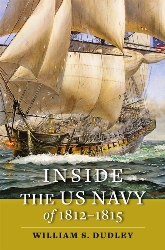 Pirates and Privateers Pirates and Privateers
The History of Maritime
Piracy
Cindy Vallar, Editor
& Reviewer
P.O. Box 425,
Keller, TX 76244-0425
    
Books for Adults ~ History: Navy
& History: Maritime
Inside the US Navy of 1812-1815
Maritime Maryland

Inside the US Navy of
1812-1815
by William S. Dudley
Johns Hopkins University, 2021, ISBN 978-1-4214-4051-4,
US $54.95
    
Near the
end of this book, Dudley writes: “The purpose of
this study is to demonstrate the importance of
logistics for the US Navy in the War of 1812.
Logistics were important in all the far-flung
campaign areas, and it was as true for the British
forces as it was for the American. Those in charge
had to have a proper grasp of logistics in order for
the navy’s operations to succeed. Logistics included
all the elements of naval war except the fighting –
administration, communications, finance,
shipbuilding, acquisition of timber, hemp, and
sailcloth, recruitment, training, supply
(requisitions, provisions, and material),
transportation, ordnance (guns, powder, related
equipment), medical necessities, and competent
leadership.” (290)
When President Madison declares war in June of 1812,
the United States is ill prepared. Six months
earlier, the US Navy numbers just over 7,000 men.
Comparing the number of their ships with those of
the enemy is akin to a goldfish confronting a whale.
Dudley, by viewing the war through a different lens,
masterfully succeeds in demonstrating how and why
administration and logistics are so key. He draws on
period documents, some of which are quoted within
the text, to showcase how Paul Hamilton and William
Jones, the two civilians who hold the post of
Secretary of the Navy during this period, do their
jobs without sufficient staff and with limited
funds. The task before them isn’t easy and each has
his own challenges to deal with, but in spite of
some losses and failures, the US Navy holds its own
against a battle-hardened, veteran maritime force.
By the time war ends, more than 15,000 men serve and
the navy is on a far better footing than when
hostilities begin.
Paul Hamilton is Madison’s first Secretary of the
Navy, serving as such from March 1809 until the end
of 1812. His background – serving in the
Revolutionary War and South Carolina’s legislature,
as well as being governor of that state, and his
knowledge of finances and having congressional
friends – provides administrative experience, but he
lacks actual expertise in ships and sailing. William
Jones, on the other hand, is a former privateer
during America’s first war with Britain, has sailed
to a number of foreign ports as captain of merchant
ships, and personally knows officers who serve in
the navy.
The book is divided into fifteen chapters that
interweave the logistics and administration of the
navy with what occurs in the war. What follows is a
summary of what each chapter encompasses.
“The Resources for Naval War” discusses the infancy
of the US Navy and the establishment of the Navy
Department, its participation in the Quasi-War with
France and war with Tripoli, initial aspects of
logistics – navy yards, ships, personnel, pay,
rations, and weaponry – and contentious encounters
that are harbingers of the War of 1812 (the Chesapeake-Leopard
Affair and the Little Belt Incident).
Paul Hamilton’s tenure as Secretary of the Navy is
the focus of chapter two. Aside from medical needs
of the navy and Jefferson’s gunboats, Hamilton’s
interactions with his staff and Congress, Isaac
Chauncey’s command of the navy yard at Sackets
Harbor, and naval patrols between June 1812 and
April 1813, are explored.
“William Jones’s Challenge” shows how he is chosen
to serve as the chief administrator of the US Navy
and how he reforms his department. One quandary he
has to face is that of a second front. Not only do
his ships and men sail the seas, they also have to
fight on the Great Lakes, including participation in
two joint amphibious operations (York and Niagara).
Oliver Hazard Perry, the Battle of Lake Erie, and
the Lake Huron Expedition are the primary foci of
chapter four. The logistics of manning the navy’s
ships, competition with privateers, and where
munitions are obtained in order to arm naval vessels
are discussed in the fifth chapter.
“The British Blockade of 1813-1814” analyzes the
enemy’s experience with and effect of blockading
American seaports along the Atlantic coast.
Additional topics include smuggling and the cruise
and loss of USS Essex.
Supplies, provisions, agents, pursers, and medical
needs on ships at sea are spotlighted in chapter
seven, while the subsequent chapter focuses on
innovation and inventions, especially Robert Fulton
and his experiments in undersea warfare.
“Chauncey’s War on Lake Ontario” returns to the
Naval Base at Sackets Harbor and campaigns on the
Great Lakes during 1814, as well as plans for
continued fighting in the new year. Afterward,
Thomas Macdonough’s activities on Lake Champlain,
smuggling, and the two opposing naval forces are
discussed in chapter ten.
The spotlight on the war moves from the Canadian
theater to that of Maryland, Virginia, and
Washington in chapter eleven. Primary emphasis is
placed on Joshua Barney and the US Navy’s Chesapeake
Flotilla, but the British invasion of Washington,
the ransom of Alexandria, the successful defense of
Baltimore, and the Royal Navy’s withdrawal are
reviewed.
After the attacks on the nation’s capital and
Baltimore, attention shifts to the southern seaports
in chapter twelve. Particular attention is placed on
Britain’s new objective – capturing New Orleans and
controlling the Mississippi River – and the role the
US Navy plays in protecting the area both before and
during the Battle of New Orleans.
To better understand what it is like to serve on
navy ships during this time period, “Sailors’ Life
and Work” examines everyday life at sea, discipline
and punishment, and casualties. Also covered are
Blacks in the US Navy and what happens when sailors
become prisoners of war.
The last two chapters – “War Finance and the
Blockade” and “Renewal of the US Navy” – pertain to
Albert Gallatin and the country’s war debts, the
impact of the Royal Navy’s blockade, peace
negotiations, Washington in the aftermath of the
British invasion, William Jones’s legacy,
demobilization, and the final naval engagements at
sea.
Dudley includes illustrations, maps, and tables that
help to put a human face on the US Navy in the
second decade of the 19th century. Notes, which
include full source citations, and an index complete
the study. The only drawback in this addition to
Johns Hopkins Books on the War of 1812 series, is
the font; if it were larger or darker, it would
cause readers less eye strain.
Inside the US Navy of 1812-1815 serves a
vital function, illuminating an aspect of the war
that is often glossed over in other studies. Dudley
makes a compelling and engaging argument for the
importance of administration and logistics, which,
in turn, makes this book an invaluable resource for
anyone interested in the second war between the
United States and Great Britain.

Maritime Maryland: A History
by William S. Dudley
Johns Hopkins University, 2010, ISBN
978-0-8018-9475-6, US $50.00
Long
associated with Maryland, Dudley provides
readers with an encapsulated view of this
state’s waterways and the events that have
impacted her history and development. He
opens with Captain John Smith’s discovery
of Chesapeake Bay, and then expounds on
the colony’s founding after King Charles I
provides a land grant to Cecil Calvert,
the second Lord of Baltimore. Dudley also
discusses the founding of Fells Point and
its importance to shipbuilding, as well as
the various marine trades that became
vital to the state’s maritime industry. In
subsequent chapters he covers the first
naval ships built here, as well as other
important aspects of the American navy to
Maryland’s development and protection, the
privateers for which Baltimore became
famous, the introduction of steam-powered
vessels and the subsequent steam industry,
and economic ups and downs of maritime
commerce. Other chapters examine the
marine life that provides income to the
watermen who fish in Maryland waters, the
steel industry, the decline of working
sail, pleasure boating and racing,
maritime archaeology, cultural resources
(museums, USS Constellation, Pride
of Baltimore, lighthouses), and the
environmental impact on the Chesapeake and
her tributaries.
The book concludes with
chapter notes, a nautical glossary, an
essay on sources, and an index. Although
the first three chapters lack
illustrations, these do accompany the rest
of the narrative and a color collection of
them exists at the book’s center. The only
drawback is the print size; it’s small and
strains the eyes.
Maritime Maryland is a
good introduction to a vital part of this
state’s history and commerce. It provides
those who want to learn more with great
starting places for further research. It
is an important resource for any maritime
collection, especially for those with
special interests in Maryland and her
contributions to history and the economy.
Review
Copyright ©2010 Cindy Vallar

Click to contact me
Background image compliments
of Anke's Graphics |


